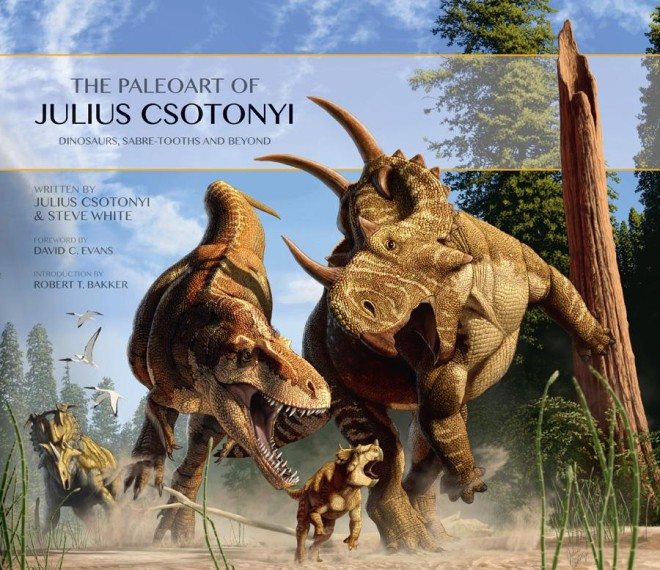Titan Books’ The Paleoart of Julius Csotonyi is a rare beast of an art book: It’s visually incredible, of course, but it’s also content-rich, exhilarating, inspiring, and eye-opening.
On his website, Csotonyi says his scientific background — he has a Ph.D. in microbiology — “impelled me to strive to restore as realistically as possible the curiously alien environments that earth has hosted in its deep past.”
And indeed, as Dr. Robert T. Bakker notes in his introduction, a good deal of Csotonyi’s work aims to “capture vivid episodes in the Darwinian drama, moments of Deep Time that actually happened.”
For example, this digital painting “attempts to restore some of the events leading to the creation of a large block of highly fossiliferous (mainly Utahraptor over a range of ontogenetic stages) sandstone from the Cretaceous in what is now Utah.”

Co-written by Steve White (who previously edited Titan’s Dinosaur Art: The World’s Greatest Paleoart), this book focusing solely on Csotonyi’s work offers not just page after page of amazing illustrations, but a hefty amount of supporting text.
Here’s an excerpt from the description accompanying an illustration of Pliocene Arctic camels, provided by Dr. Natalia Rybczynski at the Canadian Museum of Nature:
Notice larch and birch trees, the sedges, the beaver cut stump, evidence of forest fire, and the ducks (scaups) — all are based on fossil evidence from the fossil record of west central Ellesmere Ilsland. There is also a small stream transporting sediment to an ice-free ocean in the background. Julius is able to include these details, which represent important landscape processes in the Pliocene High Arctic.
It’s a testament to the book’s fascinating details that while I was reading it, I kept stopping to go online and read more about some factoid or passing mention. For instance:
- The Trachodon mummy
- Medusaceratops lokii (Yep. Named for exactly who you think it is.)
- Snell’s window
- The Green River Formation
I only had two minor quibbles with the book. First is that the text feels just a couple points too small, making it a tad uncomfortable to read, particularly those sections that are printed against non-white backgrounds. Second, I wished that the works specifically based on real-world locations had been accompanied by locator diagrams or maps.
Neither of those things, however, prevents me from strongly recommending The Paleoart of Julius Csotonyi.
Besides, the book also includes a double-page spread titled “Ceratopian Cornucopia.” Here’s half of it:

You can follow Julius Csotonyi on Twitter.
I also recommend Titan Books’ The Art of John Harris.
Disclosure: GeekDad received a copy of this book for review.




